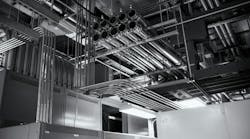A production line seems to have one problem or another every other day. This has been going on for months. Now a second line recently started doing the same thing. Everyone agrees the repair techs are good. They respond promptly, quickly identify the problem, and get the line going again. Nevertheless, the interruptions are still costly.
Reports run from the Computerized Maintenance Management System (CMMS) verify what the repair techs and operators said about the nature of the problems; they vary all over the place. But in 25% of the repairs, the CMMS revealed a pattern indicating a power quality problem. Could the other 75% also have a root cause? How would you find it?
Root causes aren’t necessarily things like power quality or bad connections. In fact, they are often the human factor. The repair techs were recognized as being good because of their speed not because of their thoroughness.
Examine that line carefully to note the functional relationships of various items that were repaired. For example, three different indicator lamps in the main control panel went out at three different times within weeks of each other; replacing all of the indicator lamps on that second repair would have prevented the third (and the fourth, which hasn’t happened yet).
Modify repair procedures/checklists so they address functionally related equipment. Preventive repair/replacement during a downtime incident reduces overall downtime.




